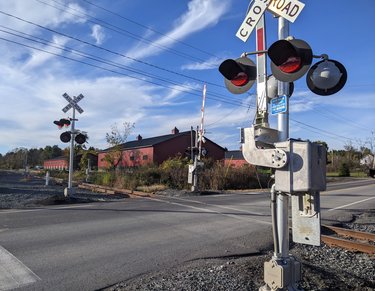Ongoing suit: Norfolk Southern versus Voorheesville
VOORHEESVILLE — The latest legal back-and-forth in Norfolk Southern’s lawsuit against the village of Voorheesville over its decision to halt work at the freight carrier’s School Road crew-charge facility is starting to look like a civics class come to life.
In multiple court filings made since first dropping its federal suit in early October, Norfolk Southern has asked for a declaratory judgment stating that federal jurisdiction over the railroad industry preempts village zoning law along with a prior settlement agreement between the sides.
Norfolk Southern went on to argue that federal statute, specifically the 1995 Interstate Commerce Commission Termination Act, broadly exempts railroads from local land-use regulations, which would void the village’s stop-work order, rendering it unenforceable. The company sought to bolster its request for a preliminary injunction that, if granted, would stop and then prohibit the village from taking any further action against the carrier.
Voorheesville maintains the proposed facility would block a critical rail crossing, which could sever half of the village from emergency services in addition to creating a hazard during school dismissal time.
The village also argued that Norfolk Southern violated a prior settlement in which the company had voluntarily agreed that it would work to minimize its project’s impact on the community while also agreeing to take part in the site-plan review process.
The stop-work order
The conflict between Norfolk Southern and Voorheesville began on Sept. 10, a date which Norfolk Southern cites as evidence of the village’s intent to obstruct commerce.
On that day, the railroad sent a letter to Voorheesville’s code-enforcement officer, Steve Mason, outlining its construction plan as a courtesy to the village while simultaneously asserting it was exempt from local permitting.
The same day, Mason issued a formal stop-work order.
The village ordered the railroad to cease and desist based on two specific violations of Voorheesville’s zoning laws.
The first violation the order cited concerned “development and building proposals for non-residential uses,” which relates to a provision in Voorheesville's zoning code that requires anyone planning to construct or develop property for commercial, industrial, or other non-residential purposes to submit detailed plans to the village planning commission for review and approval before beginning work.
The village’s position was that Norfolk Southern’s proposed crew-change facility constituted a non-residential use that required village review. By starting site preparation work — clearing trees and grading the land — without having first obtained approval from the planning commission, Norfolk Southern was allegedly violating this requirement.
The second violation addressed “proposals to expand or demolish existing business or industrial facilities or any proposals to alter existing business or industrial sites in relation to parking access, landscaping storage or any other site feature.”
This is a broader provision that catches situations where someone isn't necessarily building something entirely new but is modifying, expanding, or changing how an existing business or industrial property operates.
Norfolk Southern acquired its property from an existing industrial business, JC Pops Industrial Park. The village argued the sale was a carving out a parcel from a larger industrial property that altered the site in ways that required planning-commission review.
Norfolk Southern countered that, while Voorheesville had these laws on its books, they have nothing to do with the railroad company, which argued that the Interstate Commerce Commission Termination Act provides categorical preemption for railroad construction.
Norfolk Southern contended that local zoning laws that require a railroad to ask permission via permits or site-plan reviews effectively grant the municipality veto power over federal infrastructure. Furthermore, the railroad argued that the village’s invocation of the zoning code is a pretext.
Norfolk Southern claimed the village was using neutral zoning laws to achieve an impermissible goal: blocking the operation of the Southern Route and enforcing the 2021 Settlement Agreement through the back door. If the court agreed with Norfolk Southern, the stop-work order would be void, Norfolk Southern maintained, because the village never had the jurisdiction to issue it.
Illegal carveout?
With the federal government’s power established, the village recently filed a third-party suit against JC Pops, arguing that, when the company sold the parcel to Norfolk Southern, it carved the land out of a larger industrial lot without obtaining subdivision approval.
The village asserts this was an illegal carveout that violated local subdivision law, meaning the conveyance is void and invalid, and the remaining property owned by JC Pops is now non-compliant with minimum lot size requirements.
By targeting JC Pops, a non-railroad entity, the village is attempting to bypass ICCTA preemption, Norfolk Southern claims, effectively admitting, since it cannot regulate the railroad, Voorheesville will regulate the land transaction that brought the carrier here.
However, Norfolk Southern’s defense rests on a decision made in a 1993 lawsuit whose parties also happened to be located in the village, Voorheesville Rod and Gun Club v. E.W. Tompkins.
In its decision, that court found that a failure to obtain subdivision approval did not invalidate the transfer of a title, Norfolk Southern argued. So, while the village can fine JC Pops, seeking up to $250 per day per violation, it likely can’t void the deed or evict the railroad based on three-decade-old precedent.
The ‘Southern Route’
At the core of Norfolk Southern’s legal fight is logistics, being able to get its freight from here to there.
The “Southern Route” as it is called, will be a newly activated and dedicated route designed to capture a major share of the car-moving freight market between New York and New England. The route spans approximately 161.5 miles, running from Voorheesville in eastern New York to Ayer, Massachusetts, with key intermediate access near Worcester.
For Norfolk Southern, this corridor solves a major efficiency problem.
The Southern Route is largely owned by CSX. It starts in Voorheesville, traverses CSX’s railyard in Selkirk, crosses the border into Massachusetts near Pittsfield, follows the approximate path of Interstate 90 until it hits Worcester, then heads northeast toward Ayer.
Ayer is home to a 52-acre freight hub 35 miles northwest of Boston, which is also home to a 13-acre Norfolk Southern automotive distribution facility.
The “Northern Route” begins at Rotterdam Junction and heads east toward Mechanicville, clips the edge of Vermont and enters Massachusetts near North Adams. The route then follows the approximate course of a major state highway, Route 2, toward Ayer. The Northern Route is mostly owned by Pan Am Southern, which is half-owned by Norfolk Southern.
The Southern Route would allow Norfolk Southern to move one of its 9,000-foot-long double-stacked trains within 35 miles of Boston without having to stop in Saratoga County to take the top stack off the train to make it through a too-low tunnel in Massachusetts.
When it was still in the process of obtaining rights to CSX’s rails, Norfolk Southern told the federal regulator of the nation’s largest railroad companies, the Surface Transportation Board, that it needed to obtain the track rights because they were “necessary to improve [Norfolk Southern’s] ability to move intermodal traffic and automotive vehicles into the greater Boston marketplace.”
Intermodal traffic is freight moved in containers.
Norfolk Southern’s logistical issues are compounded because it does not own any of the rail line for 161 miles between Voorheesville and 35 miles northwest of Boston.
The company ultimately received the track rights in 2022, but the issue of rights approval continues to play out. While potentially lucrative, rights approval is in essence a highly restrictive permission slip.
Yes, Norfolk Southern can run its double-deckered 1.7-mile-long specialty train along the route twice a day every day, but there is no deviation from the route and no stopping for any reason, which is a big reason why the carrier is building its crew-charge facility in Voorheesville.
Once Norfolk Southern passes over the intersection of Skyler Lane and Main Street in the village and on to CSX’s rail line, the carrier will find itself in a precarious position, a no man’s land that forces Norfolk Southern to keep moving until it reaches almost the other side of Massachusetts.
More than most things, it’s the village’s physical location, which once made it a thriving rail stop, that has caused it this legal headache. The issue was noted years before actually becoming one.
The STB in its approval identified that, once Norfolk Southern enters the heart of the village, the carrier is basically on a timer, a concept that conflicts with federal safety laws.
Train crews have strict limits on how many hours they can legally operate a train. The issue for Norfolk Southern is that its crews start their journey as far west as Binghamton, some 130 miles from Voorheesville, and by the time they arrive in the village, the crew is legally near the end of its work shift.
Since Norfolk Southern can’t stop and swap crews during the 161.5-mile journey along CSX tracks, the crew change has to take place as close to CSX’s territory as possible, which happens to be Voorheesville.
If the swap doesn’t take place in the village, the train can’t legally complete its journey to Massachusetts without the crew timing out, stranding the train on a competitors’ line.
Settlement agreement
Two legal documents are at the center of the dispute: the stop-work order and a 2021 settlement agreement among the village, Norfolk Southern, and CSX.
In its filings with the court, Voorheesville turns the settlement agreement into a mandate, arguing that the village agreed to withdraw its opposition to the CSX/Norfolk Southern merger only after the railroads signed the contract to minimize potential impacts on the village.
The STB approved the merger subject to conditions agreed upon by the three parties, but the village argued this approval effectively federalized the contract, and contends that Norfolk Southern’s current plan is a violation of the promise to minimize impact.
The village argued that, depending on location, a stopped train could block all three Voorheesville’s surface crossings, potentially severing emergency access to half the town, which constitutes a material breach. By violating the conditions of its federal license, the village argues, Norfolk Southern forfeits the very federal protections it is now trying to hide behind.
The freight carrier also sought to use the settlement agreement to bolster its case, arguing that the village had willfully misinterpreted both the law and the railroad company’s operational plan.
Norfolk Southern argued that “minimize” did not mean “eliminate” impact, contending that trains blocking roads are an unavoidable reality of physics, not a violation of a contract.
To show its minimizing impacts, Norfolk Southern provided a specific staging plan for its trains. Those heading eastbound will be staged west of the School Street crossing, while westbound trains will stop at a designated landing pad near Hennessy Road.
The company asserted these stop points are calculated specifically to keep crossings clear while the train is stationary during crew swaps, but also admits that moving trains will temporarily block crossings while decelerating or accelerating.
Norfolk Southern also argued that the village used the stop-work order as pretext to enforce the settlement agreement, claiming that Voorheesville knew it couldn’t win a straightforward contract dispute, so it invoked its zoning code to drag Norfolk Southern back to the negotiating table.
The freight carrier concluded that, if Voorheesville truly believed the agreement had been breached, the only remedy is to petition the Surface Transportation Board for legal enforcement, not to padlock the site. And by using its zoning laws to settle a contract dispute, Norfolk Southern claimed, the village is engaging in illegal self-help.
The case is ongoing.


